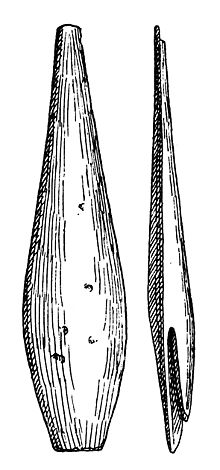Aurignac tip
The term Aurignac point was introduced by Henri Breuil around 1900 as a synonym for bullet points with a split base. It is the characteristic device of the early Aurignacien , the oldest archaeological culture of the Upper Paleolithic . Because of the lower elasticity of ivory and bone , Aurignac tips are mostly made of antler .
Sites with Aurignac tips are for example the Geißenklösterle (11 pieces), the Vogelherd cave (6 pieces) and the Istállós-kő cave .
Individual evidence
- ↑ Joachim Hahn : Recognizing and determining stone and bone artifacts - introduction to artifact morphology . Pp. 335–337, Verlag Archaeologica Venatoria, Tübingen 1991, ISBN 3-921618-31-2
- ^ A b Michael Bolus, Nicholas J. Conard : On the time of bullet tips made of organic materials in the late Middle Paleolithic and Aurignacia in Archäologisches Korrespondenzblatt , Volume 36, Issue 1, p. 10, Mainz 2006, ISSN 0342-734X
- ↑ Joachim Hahn: The Geißenklösterle Cave in the Ach Valley near Blaubeuren I . Pp. 205-208, plate 44, Konrad Theiss Verlag, Stuttgart 1988, ISBN 3-8062-0794-1
- ↑ Gustav Riek : The Ice Age Hunter Station at Vogelherd - Volume I, The Cultures . P. 156, 157, panels XXVIII, XXIX, Academic Publishing Bookshop Franz F. Heine, Tübingen 1934
